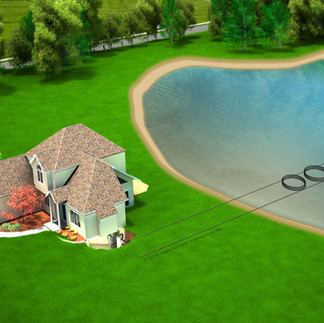Installing a Geothermal System
- TerraStream Energy
- Feb 21
- 3 min read
As homeowners in Prince George’s County and Montgomery County, Maryland, seek more sustainable and cost-effective heating and cooling solutions, geothermal systems have emerged as a leading option. By harnessing the Earth's stable underground temperature, geothermal energy provides year-round comfort, reduces reliance on fossil fuels, and delivers significant long-term savings on energy bills.

This guide will walk you through the entire process of installing a geothermal system—from the initial site assessment to system optimization and maintenance. Whether you are a homeowner looking for the best geothermal Maryland has to offer or researching the geothermal Maryland cost, this comprehensive guide will equip you with the knowledge to make an informed decision.
Understanding Geothermal Systems: Benefits and Functionality
What is a Geothermal System?
A geothermal system consists of three main components:
Ground Loop: A series of pipes buried underground that exchange heat with the Earth.
Heat Pump: Transfers heat to and from your home, acting as the main driver of the system.
Distribution System: Delivers heated or cooled air through ductwork or radiant heating systems.
Benefits of Geothermal Systems
Energy Efficiency: Geothermal heat pumps (GHPs) operate at 300%-500% efficiency, significantly lowering energy consumption.
Lower Utility Bills: Homeowners can save 30-70% on heating and cooling costs compared to conventional systems.
Eco-Friendly: Geothermal systems reduce greenhouse gas emissions and reliance on fossil fuels.
Durability: Underground components can last 50+ years, and heat pumps typically last 20-25 years.
Available Incentives: Homeowners in Maryland can benefit from residential geothermal tax credits, state rebates, and Maryland GRECs (Geothermal Renewable Energy Credits).
Learn more about how geothermal energy works.
Site Assessment and Planning for Your Geothermal System
Key Factors in Site Evaluation
Soil Composition: Affects thermal conductivity and system efficiency.
Land Availability: Determines whether horizontal or vertical ground loops are feasible.
Local Climate: Influences heating and cooling demands.
Existing Utility Lines: Helps avoid interference with underground infrastructure.
Permits and Regulations: Compliance with Montgomery County and Prince George’s County zoning laws.
Choosing the Right Geothermal System
Closed-Loop System: The most common choice, buried underground in horizontal or vertical configurations.
Open-Loop System: Uses groundwater but requires access to an abundant water source.
Hybrid System: Combines geothermal with other heating or cooling methods for added efficiency.
For more on geothermal technology, visit National Renewable Energy Laboratory.
Geothermal Installation Process
Step 1: Site Preparation
Clearing and marking the area for excavation.
Soil testing to confirm optimal heat transfer properties.
Step 2: Ground Loop Installation
Horizontal Loops: Installed in trenches 4-6 feet deep.
Vertical Loops: Drilled 100-400 feet underground for properties with less space.
Step 3: Heat Pump Installation
Typically installed indoors (basement or utility room).
Connected to the ground loop and existing HVAC ductwork.
Step 4: System Integration
Connecting to radiant floor heating or ductwork.
Smart thermostat integration for maximum energy efficiency.
Step 5: Testing and Calibration
Pressure testing to ensure no leaks.
Running the system in both heating and cooling modes to verify performance.
For more details on installation, check out the U.S. Department of Energy guide.
Cost of Installing a Geothermal System in Maryland
Average Installation Costs
System Type | Estimated Cost Range |
Closed-Loop | $20,000 - $30,000 |
Open-Loop | $15,000 - $25,000 |
Hybrid | $20,000 - $35,000 |
Key Cost Factors
Property Size: Larger homes require more extensive systems.
Soil and Drilling Costs: Rocky or dense soil increases excavation expenses.
Permitting & Labor: Costs vary by Montgomery and Prince George’s County regulations.
For more on Maryland geothermal pricing, visit the Maryland Energy Administration.
Federal Tax Credits
30% tax credit for residential geothermal installations.
Claimable through IRS Form 5695.
Maryland State Incentives
Maryland Energy Administration Grants for geothermal projects.
Property tax exemptions for renewable energy installations.
Utility Rebates
Companies like Pepco and BGE offer geothermal rebates.
Check available programs at Maryland Geothermal Association.
Questions to Ask Before Hiring a Contractor
Are you licensed in Maryland for geothermal installations?
How many geothermal systems have you installed in Montgomery/Prince George’s County?
What warranties do you offer on equipment and labor?
Do you handle permits and paperwork for rebates?
Recommended Installer: Maryland Geothermal
For expert geothermal installers in Maryland, contact Maryland Geothermal.
Post-Installation Maintenance and Optimization
Routine Maintenance Checklist
✅ Inspect air filters monthly.
✅ Check loop pressure annually.
✅ Schedule professional servicing every 1-2 years.
✅ Optimize efficiency with programmable thermostats.
Learn more about geothermal maintenance at Energy.gov.
Conclusion: Is Geothermal Right for You?
Geothermal energy is a smart investment for homeowners in Prince George’s County and Montgomery County, offering lower energy costs, eco-friendly benefits, and long-term savings. With available incentives, reduced maintenance, and increasing energy efficiency, installing a geothermal system is a step toward a sustainable future.
For expert guidance, cost estimates, and installation services, contact Maryland Geothermal today!






Comments